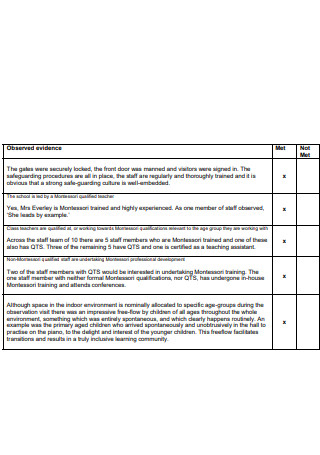4+ SAMPLE Child Observation Report
FREE Child Observation Report s to Download
4+ SAMPLE Child Observation Report
What Is a Child Observation Report?
Methods Used in Child Observation
How to Create a Child Observation Report
FAQs
What is the purpose of a Child Observation Report?
How do you make a good Child Observation Report?
What are the skills needed to make a good observation report?
Why is a child observation report important in the education system?
What are the benefits of applying the child observation report?
What are the advantages of having a ready-made observation report template?
Amos Bronson Alcott, famous American educator, philosopher and education reformer, once said, “Observation more than books and experience more than persons, are the prime educators.” Observation as a science is described as the process of examining, monitoring or analyzing carefully someone or something in order to acquire information. This type of process is often applied in education through a child’s development process, which includes a child’s psychological, emotional, and biological changes. Learning and exploring are the foundation of an early childhood education. For child care providers and educators, child observation is the method used to assess a child’s development, often formulated into what is known as the child observation report.
What Is a Child Observation Report?
A child observation report is a documentation that includes a detailed description and information about a child. Often used as a basis in assessing a child’s growth and overall psychological, emotional and biological changes, it includes the process of listening, watching, interviewing, note-taking, and scrutinizing the action and words of a child, or children, as they respond to the stimulus in their surroundings. This type of report is important in forming the decisions of parents and educators in addressing the needs of a child in their early development years through the making of a school development plan. Sometimes, this can also be the Teacher Action plan. The goals should be clearly defined when making a child observation report. It often includes noting down the child’s milestones or learning progress; any type of actions plans, if needed, to improve the child’s behavior; and a close monitoring of a child’s language development.
Observing the child’s behavior plan can help an educator find out what interests a child. Done in a controlled environment, the educator studies how the child reacts to what is going on in their environment, usually done in a classroom setting. The educator approaches the child, asking, “How was your day?” or “What are you doing?” or “Why did you pick this color?” or “Is this flower beautiful?” Whatever responses the child gives is recorded and will be used as a basis in rating where the child falls in their level of development progress.
An NCBI article notes that, “The implications of (observations of children’s interactions) these findings might encourage teachers to be thoughtful and intentional about what types of support and resources are provided so children can successfully navigate the demands of particular settings.” It further says that, “By providing an evidenced-based picture of the conditions under which children display the most positive interactions, teachers can be more aware of choices within these settings and have a powerful way to assist in professional development and interventions.” All of these further highlights the importance and the huge impact a child observation report can have on a child’s future. For educators, for parents, and for the authors of the report, it is a must that every detail included in the report is subject, factual, and that the recommendations taken later in making the school plan are made with the welfare of the child concerned put in the greatest consideration.
Methods Used in Child Observation
Child observation is very significant in finding out and understanding better the strengths and weaknesses of a child. It is an important process that helps in creating action plans and recommendations that will facilitate better learning for the child, and/or enhance or develop a child’s skill. In the case of a child observation report, its significance is all the more highlighted since the impact of the report could greatly affect the child’s future. Parents and decision makers often use this report as their basis of determining what necessary actions need to be taken to further improve the child’s progress or development. Over the years, practitioners or educators have accumulated lots of tools in the practice of child observations. They have explored different settings and stimuli environments, with the goal in mind of encouraging a response from the child subject. The methods used proved to be successful in most cases. Whether done in a formal setup or in an informal setting, these are the common methods used when doing child observation.
How to Create a Child Observation Report
There is no hard and fast rule when it comes to making a child observation report. The observer, though, just always needs to keep in mind to remain as objective as possible when making the report. Always remember that when making the report, whatever observations, details, or information is written will hugely impact the subject child’s future. There are lots of ready-made observation or assessment report templates available to choose from. On our website, we have a variety of assessment report templates that you can use to formulate your own child observation report.
As we mentioned, there are no strict format or guidelines to follow when making a child observation report, as long as all the essential elements are included when doing the observation report. If you wanted to know more about the gist of creating a child observation report, read on.
Step 1. Setting the Scenario
You need to decide on the time and place for the observation to take place. Now, this will depend on what kind of information or answers you are trying to get. If you want to observe the child’s social development, the setting could be during the class recess period. If you want to observe the child’s mental progress, the setting could be during a standardized test set up.
Step 2. Include the Contextual Information
Jot down the date, time, and the place where the observation is taking place. Include the name of the child, the teacher, your name as the observer, and all other relevant person’s names involved in the report.
Step 3. Data Collection
This is the step where you apply the methods used for observation. Write down narrative, descriptive, and objective paragraphs of the observations you had made. You can use the Antecedent-Behavior-Consequence format of the NAEYC, or the National Association for the Education of Young Children. Basically, NAEYC’s format is to write down what happened right before (the situation), what happened, and what happened right after (the situation). While you’re noting down all of this information, observe for any kinds of patterns. This step will help you formulate later on any recommendations needed to be taken.
Step 4. Data Analysis
Simply put, the interpretation of the data collected. Review your notes and analyze the timeline of the events that occurred. Be objective, or avoid being judgmental. Focus on what the child is doing. Describe only what happened. Write down any patterns that have occurred during your observation. These are some of the questions that you can use when doing your data analysis: What are they doing, and what might be the reason they’re doing this? What is motivating or inspiring them in doing this? What are the theories or related studies that can support my analysis or interpretation? What kind of language or communication is being used by the child? What kinds of backgrounds, such as cultural or family, might have an impact on the child’s development? Remember that when making your analysis, this is always based on the observation methods that you have previously performed.
Step 5. Planning and Recommendation
This is where you need to plan out the course of action to improve and develop the learning of the child, using the observation and the analysis you have made. Think about what skills, capabilities, areas of interest of the child you want to focus on in planning the recommendations or the course of action. Recommend activities that can further develop or improve the child’s skills. Do not ignore the child’s areas for improvement. Plan activities that can gently push the child into developing the needed skills to help in his or her growth.
FAQs
What is the purpose of a Child Observation Report?
An observation is an important process of good program planning. In the same way, a child observation report is an important tool to determine a child’s developmental progress, either biological, mental, emotional, social, or psychological. It provides the foundation for creating a school plan to help the child’s progress, to further enhance the child’s existing skill, or to help the child develop a new skill.
How do you make a good Child Observation Report?
Be objective throughout the process. Know your subject or the child well, by noting the child’s background, history, et cetera. Do the best method that is appropriate to the child’s situation. Make sure to be very keen and detailed when making the observation. Be very detailed when collecting records or data. Be factual. Stick to the questions of what, why, when, where, who and how to remain objective. Make a timeline chart of the events that happened. When making recommendations, always keep in mind that whatever you have written down will have a big impact on the child’s future.
What are the skills needed to make a good observation report?
Be inquisitive. Have a good attention to detail. Always make a record of all the events within the set up, or have a good record keeping process in place. Have good communication skills, be as engaging as possible. Be objective.
Why is a child observation report important in the education system?
A child observation report is important in the education system because it helps persons in authority, the parents and the teachers, make informed decisions on a child’s welfare. The report contains a systematic detailed outline of a child’s progress, or lack thereof, and makes recommendations according to areas that need improvement or further development.
What are the benefits of applying the child observation report?
One of the benefits of the child observation report is that it helps identify the strengths and weaknesses of the subject child. Through the observation methods conducted and with the proper planning and recommendations, it helps enhance, improve, and/or develop the child’s skills.
What are the advantages of having a ready-made observation report template?
A ready-made template saves you time in coming up with a structure in creating your report. It usually has an existing structure that all you need to do is just to fill in the blanks as necessary. It generally already outlines the steps that you need to take in making the report.
If you’re a teacher or a parent of a child that seems to stand out from the rest of his or her peers, you need to pay attention to whether that particular skill or behavior merits further observation. A child observation report does not necessarily have to be applied only for the negative or alarming outward behaviors a child portrays, it is also a very useful tool for those children who have existing skills and talents that need further development. And the report could also be used during a child’s very early years to determine at an early stage which path your child could best progress on.
The fact that this is the basis used by decision-makers in formulating educational tools and programs that greatly impacts our children’s future tells us that the child observation report is one of the most useful tools there is in our education system. Alcott has realistically put it into perspective that observation(s) are the prime educators. Having a good child observation report means that the right kind of observation method was applied, the right interpretation and analysis was made, and the appropriate planning and recommendation was given. Making an observation report should not be that difficult with our existing observation report templates. Our templates are accessible and ready for download on our website. So go ahead and check out our report templates, and see how easy and convenient it is for you to create that child observation report and make a difference in a child’s life!





